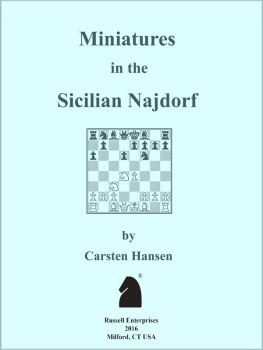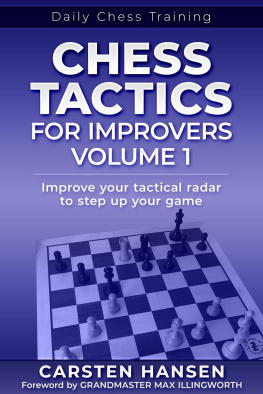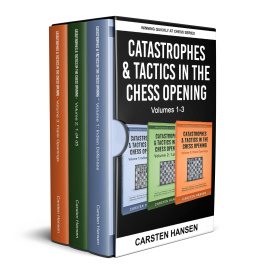Carsten Hansen - Chessable Lifetime Repertoires: 1. c4 ⁄ 1. Nf3 - Part 1 Opening course
Here you can read online Carsten Hansen - Chessable Lifetime Repertoires: 1. c4 ⁄ 1. Nf3 - Part 1 Opening course full text of the book (entire story) in english for free. Download pdf and epub, get meaning, cover and reviews about this ebook. genre: Children. Description of the work, (preface) as well as reviews are available. Best literature library LitArk.com created for fans of good reading and offers a wide selection of genres:
Romance novel
Science fiction
Adventure
Detective
Science
History
Home and family
Prose
Art
Politics
Computer
Non-fiction
Religion
Business
Children
Humor
Choose a favorite category and find really read worthwhile books. Enjoy immersion in the world of imagination, feel the emotions of the characters or learn something new for yourself, make an fascinating discovery.

- Book:Chessable Lifetime Repertoires: 1. c4 ⁄ 1. Nf3 - Part 1 Opening course
- Author:
- Genre:
- Rating:4 / 5
- Favourites:Add to favourites
- Your mark:
- 80
- 1
- 2
- 3
- 4
- 5
Chessable Lifetime Repertoires: 1. c4 ⁄ 1. Nf3 - Part 1 Opening course: summary, description and annotation
We offer to read an annotation, description, summary or preface (depends on what the author of the book "Chessable Lifetime Repertoires: 1. c4 ⁄ 1. Nf3 - Part 1 Opening course" wrote himself). If you haven't found the necessary information about the book — write in the comments, we will try to find it.
Chessable Lifetime Repertoires: 1. c4 ⁄ 1. Nf3 - Part 1 Opening course — read online for free the complete book (whole text) full work
Below is the text of the book, divided by pages. System saving the place of the last page read, allows you to conveniently read the book "Chessable Lifetime Repertoires: 1. c4 ⁄ 1. Nf3 - Part 1 Opening course" online for free, without having to search again every time where you left off. Put a bookmark, and you can go to the page where you finished reading at any time.
Font size:
Interval:
Bookmark:
[Event ?]
[Site ?]
[Date ????.??.??]
[Round ?]
[White Introduction & Quickstarter Guide]
[Black Introduction]
[Result *]
{ Hello and Welcome to Lifetime Repertoire: 1.c4/1.Nf3 Part 1. This first Chapter serves as an introduction and overview of the course and presents the most important lines to get you started quickly with playing 1. c4 and 1. Nf3. Yes, this course actually covers a full repertoire for White, that can be employed by starting with 1. c4 and 1. Nf3, depending on your preference. The lines and move orders are selected in a way that most chapters quickly merge and reach setups that can be reached by both first moves. We will discuss this in more detail in a moment, but first of all want to talk briefly about the concept of a Lifetime Repertoire. A Lifetime Repertoire is designed to last a lifetime, so it has to stand the test of time and is selected having the following criteria in mind. This is not an official list by Chessable, but our interpretation. 1. It must be fundamentally sound. 2. Should be based on well tested lines and profound new ideas. 3. Allows some flexibility and modifiability for the future. 4. Usable for a wide range of playing levels. 5. Aims to put pressure on the opponent without unwarranted risk. @@StartBracket@@clearly related to 1.@@EndBracket@@ Having these criteria in mind, you need to decide on your concept for a course based on 1. c4 and 1. Nf3. The most important difference between 1. e4 and the 1. d4/1. c4/1. Nf3 complex is the importance of move orders. After 1. e4 move order considerations are of minor importance, at least very early on. For example, your approach with White after 1.e4 e5 has no significance at all for your choice against 1.e4 c6 or 1.e4 e6 The first move already sets the tone of the opening and you can attach a label to it. If you decide to switch your play against the French, you can do so without any additional work needed for a second reply. There are just no transpositions between 1.e4 e6 and 1.e4 e5 or at least no relevant ones, for the nitpicky. This is an entirely different story in the world outside of 1. e4. Move decisions on move 2 or 3 may have an influence on many openings, as the specific lines are often only determined after a sequence of moves. Looking at our topic, you may look at the situation after 1.c4 Nf6 At this point, you dont know the opening you will play today. You only have one piece of information - the Knight is on f6, and its not going to be a Dutch style 1.c4 f5 opening. During the next few moves both sides have a range of options, and with each move add a piece to the puzzle What opening do we play today?. For example, lets say you elect to play the move 2. Nf3 after the initial 1. c4 Nf6. Now Black knows that in case of a Kings Indian setup @@StartBracket@@ g6 and d6 most of the time@@EndBracket@@ we dont have the option to play with an early f-pawn move, like f3 @@StartBracket@@Saemisch@@EndBracket@@ or f4 @@StartBracket@@Four Pawns attack@@EndBracket@@. On the other hand, with 2. Nf3 we make sure that e5 is ruled out, a move was still possible after 2. Nc3 or 2. g3. So with every move both sides give some information and narrow both their choices to some extent. Now, our job as authors is to design a repertoire that cannot be move-ordered, as you call it. We need to present a move order concept that reliably leads to lines, that are part of the discussed repertoire. Single decisions like What to play against a Kings Indian setup? need to perfectly fit into the overall repertoire, making sure that you get your lines all the time. Now, lets discuss some key decisions for the actual repertoire and why we chose them, based on the mentioned guidelines. The actual lines in this Quickstarter Guide and of course the full Chapters give more details on each selection. A. Reversed Sicilian 1. c4 e5 - Whites main call is between 2. g3-based lines or a different approach. We decided to play 2. Nc3 and aim for the Four Knights Variation with 4. e3, a well respected main line that has gained momentum over recent years. Our general approach to 1. c4 e5 is to play ambitiously and aim to play the move d4 as much as possible, and occupy the centre with pawns. We play lines like 1.c4 e5 2.Nc3 Bb4 3.Nd5 Be7 4.d4 d6 5.e4 1.c4 e5 2.Nc3 Nc6 3.Nf3 g6 4.d4! or 1.c4 e5 2.Nc3 Nc6 3.Nf3 f5 4.g3 Nf6 5.d4! for example. These lines are challenging for Black and built around the Four Knights after 1.c4 e5 2.Nc3 Nc6 3.Nf3 Nf6 after which we opt for the mentioned 4.e3 We make a good case for 4. e3, but in addition White has a wide range of alternatives, which makes this choice ideal for a Lifetime Repertoire. Its a framework to be modified later, if you so desire. B. Kings Indian and Grnfeld - The Kings Indian, featuring the kingside Fianchetto by Black with Nf6, g6, Bg7 and O-O is a very popular opening, in particular at the club level. It is very important to have a good weapon against it, for mostly two reasons: you will face it very frequently, and Blacks strategy is often rather risky, giving White lots of leeway in the centre. These two factors combined mean that playing well against the Kings Indian translates to many points! Now, against the Kings Indian White has two main choices after having played 1. c4 or 1. Nf3: you can stay within the bounds of the English, and play something involving d3 and g3, for example. This was the approach in Christofs 2016 course on the English, in which transpositions to non-1.c4 lines were not part of the overall concept and out of the equation. This does not apply for a Lifetime Repertoire, however. We intend to get the maximum against the Kings Indian and therefore suggest to play a main line against this opening, involving the move d4 to occupy the centre. But which one to go for? One criteria is that it ideally features the move Nf3, as this would allow for one solution that can be employed after 1. Nf3, as well. The prime candidates that fit the bill are the Classical Kings Indian @@StartBracket@@setup c4, d4, e4, Nc3, Nf3@@EndBracket@@ and the Fianchetto Kings Indian @@StartBracket@@c4, d4, Nf3, g3, Bg2@@EndBracket@@. Both lines have an excellent theoretical reputation and score well for White. Now we had to answer two key questions: which of the two fits better into a 1. c4/1. Nf3 repertoire stylistically and how are the move order implications? We think that the Fianchetto Variation is the better fit, as it is geared more towards control of the game and reducing Blacks counterplay options. Blacks chances of a kingside attack, often associated with the Classical Kings Indian, are avoided. This is an important psychological aspect, as we take away a key reason why Black chose the opening in the first place. Often Kings Indian fans dislike playing against the Fianchetto Variation, being frustrated by the solidity of Whites game. There are also many lines that feature pawn structures more typical of the English opening than the actual Kings Indian, in particular if Black plays with c5 1.c4 Nf6 2.Nf3 g6 3.d4 Bg7 4.g3 c5 is our move order, but 1.c4 c5 2.Nf3 Nf6 3.g3 g6 4.d4 Bg7 is just as plausible. Now, what about move orders? Getting to a main line Kings Indian from 1. c4/1. Nf3 is actually not that easy while avoiding move order issues. One issue is that Black has multiple ways to get his formation. Sure, they can play 1 Nf6, 2 g6,3 Bg7 and 4 O-O, but what about other ways like 1 g6 or 1 d6? These move orders are surprisingly challenging, in particular 1 g6 is tricky to handle. After 1. c4 g6 you need to be careful, as move orders like 1.c4 g6 2.Nc3 c5! or 1.c4 g6 2.g3 c5! lead to lines that we dont intend to play @@StartBracket@@see the paragraph below on the Symmetrical English@@EndBracket@@ This leaves 1.c4 g6 2.Nf3 but after 2Bg7 you face the same dilemma, as 3.g3 c5! and 3.Nc3 c5! are undesirable as well, for the same reason. If you want to play the Fianchetto Variation on our terms, you need to go for 1.c4 g6 2.Nf3 Bg7 3.d4 but here Black may change track and opt for 3Nf6 intending to play a Grnfeld after 4.g3 d5 This is a sophisticated move order, sometimes used by well prepared players and professionals. With White you either have to take up the gauntlet and learn the Fianchetto Grnfeld, or you choose to play a modest line in the Symmetrical instead. We decided that a Lifetime Repertoire should feature the more challenging option, and therefore this course also includes the Fianchetto Grnfeld. This choice makes perfect sense for multiple reasons. It is not only the most challenging option, but also an excellent long term investment of your study time. Learning the Fianchetto System against the Kings Indian and the Grnfeld provides you with excellent lines, that you can employ after 1. c4, 1. Nf3, and even after 1. d4, if you want to include this first move into your repertoire later or already play it. These are indeed lines that can serve you for a lifetime! Your early move orders are quite straightforward after mastering the Fianchetto System against the Kings Indian and the Grnfeld. 1.c4 Nf6 2.Nf3 g6 3.d4 Bg7 4.g3 or 1.c4 g6 2.Nf3 Bg7 3.d4 Nf6 4.g3 are possible and also easily reached via 1.Nf3 Nf6 2.c4 (or) 1.Nf3 g6 2.c4 This first part of the Course included coverage of the Fianchetto Kings Indian, the Fianchetto Grnfeld, and lines that start with 1 g6 and 1 d6. C. Symmetrical English 1. c4 c5 - Similar to the Reversed Sicilian, White needs to make a decision if you want to play with g3 @@StartBracket@@with 2. g3 or 2. Nc3 and then g3@@EndBracket@@ for a more closed interpretation, or rather play with an early Nf3 and aim for d4 to open up the game. We decided to go for the latter, which was also inspired by other choices in the repertoire. We heavily rely on e3, followed by d4, a common theme seen also in the Reversed Sicilian and lines that we play versus d5-setups @@StartBracket@@Queens Gambit and Slav@@EndBracket@@. This approach is currently viewed as more challenging than setups with an early g3 in the Symmetrical, and according to our experience, often less well studied by black players. We also feature the Maroczy Bind for White after 1.c4 c5 2.Nf3 g6 3.e4 Nc6 4.d4 which is Christofs favourite opening for White and Carsten has extensively written about in a classic book, together with Magnus Carlsens head coach Peter Heine Nielsen. Playing the move order 1.c4 c5 2.Nf3 has the added benefit of easily covering the move order 1.Nf3 c5 2.c4 leading to the same position. The Symmetrical English is covered in Part 2 of this course. D. 1.c4 e6 and 1.c4 c6 - Black aims for a Queens Gambit or Slav. Against both systems we advocate playing a setup with an early e3, staying flexible with the d-pawn. Often we can make good use of the long diagonal a1-h8 by deploying the bishop to b2, keeping the pawn on d2. In other cases, a later d4 may transpose to a 1.d4-style position if appropriate. The key to lines like 1.c4 c6 2.Nf3 d5 3.e3 Nf6 4.Nc3 is the flexibility - we still may play d4, but dont need to. Black needs to be aware of the differences to a regular Slav and needs to avoid getting tricked into lines of the Slav that he did not intend to play in the first place. These Anti-Slav and Anti-QGD lines have gained popularity in recent years and include many fascinating ideas that put Black under pressure. You will see many cases of an early g4 or h4, starting an attack on the kingside - on a solid foundation, of course! These lines are also reliably reached via the move order 1.Nf3 d5 2.e3 angling for a transposition with 2Nf6 3.c4 c6 or 3e6 The whole Anti-Slav and Queens Gambit complex, including the move order via 1.Nf3 d5 2.e3 is discussed in Part 2 of the course. These are the four main decisions that we wanted to discuss in this Introduction. Heres an overview of the contents included in each part of the course. Part 1: Reversed Sicilian 1. c4 e5, Fianchetto System against the Kings Indian, Fianchetto System against the Grnfeld, Black plays 1g6, Black plays 1d6, and Dutch Setups. Part 2: Symmetrical English 1.c4 c5, Anti-Queens Gambit Anti-Slav 1.Nf3 d5 2.e3 move orders, Setups with b6, Other lines. Alright, lets get into the most important lines from the first Part of the course to get you started! }
Next pageFont size:
Interval:
Bookmark:
Similar books «Chessable Lifetime Repertoires: 1. c4 ⁄ 1. Nf3 - Part 1 Opening course»
Look at similar books to Chessable Lifetime Repertoires: 1. c4 ⁄ 1. Nf3 - Part 1 Opening course. We have selected literature similar in name and meaning in the hope of providing readers with more options to find new, interesting, not yet read works.
Discussion, reviews of the book Chessable Lifetime Repertoires: 1. c4 ⁄ 1. Nf3 - Part 1 Opening course and just readers' own opinions. Leave your comments, write what you think about the work, its meaning or the main characters. Specify what exactly you liked and what you didn't like, and why you think so.



